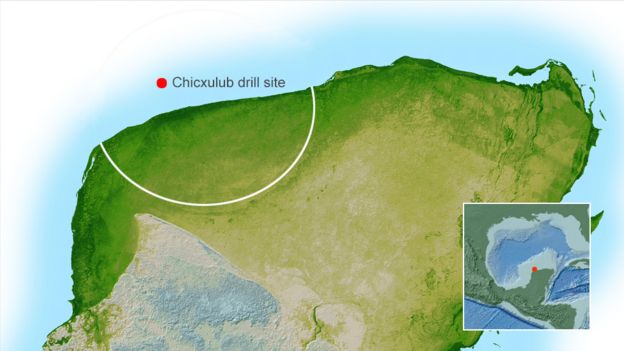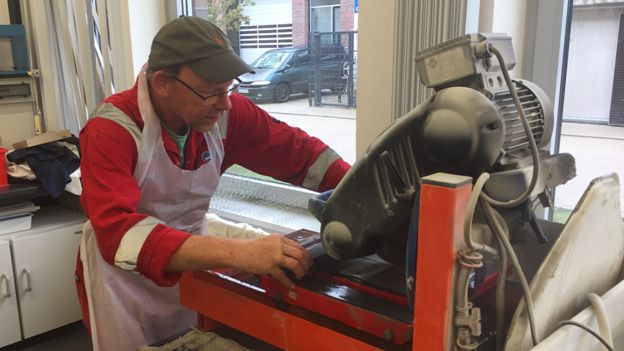Chicxulub 'dinosaur crater' investigation begins in earnest
Scientists have obtained remarkable new insights into the asteroid impact that wiped out the dinosaurs.
They have been examining rocks from the crater that the 15km-wide space object dug out of what is now the Gulf of Mexico some 66 million years ago.
The team says it can see evidence in these materials for how life returned to the scene soon after the calamity.
Descendants of these small organisms are likely thriving today in amongst the crater's smashed up materials.
The international project has shipped the hundreds of metres it drilled from beneath the Gulf floor earlier this year to the MARUM Center for Marine Environmental Sciences, at the University of Bremen, Germany.
It is here that the cores are being catalogued, analysed and archived.
Chicxulub Crater - The impact that changed life on Earth

- A 15km-wide object dug a hole in the crust 100km across and 30km deep
- This bowl then collapsed, leaving a crater 200km across and a few km deep
- Its central zone rebounded and relaxed, producing an inner "peak ring"
- Today, much of the crater is offshore, buried under 600m of sediments
- On land, it is covered by limestone deposits, but its outline is visible
- It is evident in an arc of famous sinkholes referred to as cenotes

Prof Sean Gulick, from the University of Texas, US, is one of the two chief scientists involved.
He cautioned that the rock investigation was a long-term endeavour, but then shared some early observations.
"We've been able to examine that first 10,000 years after the impact, which is dominated by what we call 'disaster species' - dominated by the organisms that love stressed environments. And then we can see evolution coming back in [during] the next few hundred thousands years after that," he told BBC News.
The "disaster species" that left their fossil traces in the rocks are tiny plankton-type organisms, such as particular forms of dinoflagellates.
But of considerable delight for the research team is evidence in the cores for what may be current biology.
These deep-living cells would be the descendants of organisms that invaded pore spaces and cracks through which hot fluids flowed. Similar life-sustaining hydrothermal systems are seen at volcanic vents at mid-ocean ridges.
"We've got some cell counts and some DNA, but it's all very early days; we're very concerned about contamination," explained Prof Jo Morgan. "But the signs are that, yes, this crater was occupied soon after the impact."

These are moments to treasure for the Imperial College London scientist. She had lobbied for 16 years to get the drill project approved and funded.
It was conducted just off the Mexican coast from April to June.
The drill mechanism got to 1,335m below the modern sea floor.
For its first 600m, it had to push through typical ocean sediments that have built up since the impact. But then, in the lower part of the hole, it hit the true rocks that make up the Chicxulub Crater, as it has become known.
"They're very strange rocks," said Prof Morgan. "The rocks have formed this feature: it's called a 'peak ring'. They're very, very highly… what we call 'shocked'. Shock pressures of many tens of gigapascals have deformed the rocks. They're also highly fractured, and have moved long distances. So, even though they're made of granite-type rocks, they're amazingly different to anything else we see in the world."

With Prof Gulick, Prof Morgan has assembled a 35-strong team to begin the process of unpacking the cores in Bremen.
Little chunks of rock are being cut and bagged to be sent to labs all across the globe.
Various team-members will lead specific inquiries.
The goal, broadly speaking, is to understand better how the crater formed, the energy involved in its excavation, and the volume of material that was dispersed.
This will put new limits on the nature of the environmental changes that overtook the Earth and sent so many species - not just the dinosaurs - into oblivion.
Prof Gulick told BBC News: "So, we think that this investigation will give us answers to some fundamental questions that people have been asking for decades, like the energy of the impact, maybe some information about the kill mechanisms that caused the mass extinction, and also fundamentally about how impact processes work [and] how impacts affect all planets in the rocky part of the Solar System."
It is certain that future teams will propose additional ideas about the impact which they will test with analytical tools not yet invented.
The expedition to drill into Chicxulub Crater was conducted by the European Consortium for Ocean Research Drilling (ECORD) as part of the International Ocean Discovery Program (IODP). The expedition was also supported by the International Continental Scientific Drilling Programme (ICDP).
Formal results will be published in a slew of scholarly papers that should start appearing very soon.
Topics of early interest will include the possibility that some vestige of the impactor itself can be found in the cores. A telltale of this meteoritic material will likely be high levels of the element iridium.
The scientists should also be able to comment on the tsunamis that occurred when the asteroid struck what was then a shallow sea. Colossal volumes of water would have sloshed back and forth and this action ought to be recorded in cascades of sediment.













0 comments
Post a Comment